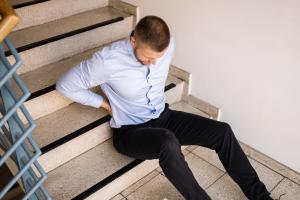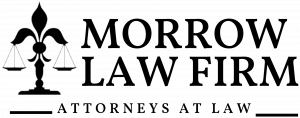The Impact of Comparative Fault Laws on Personal Injury Claims in Louisiana
If an individual is found to be 90% at fault, they can still seek damages, but the recovery would be limited to 10% of the total amount”
NEW ORLEANS, LA, UNITED STATES, January 31, 2025 /EINPresswire.com/ -- Personal injury cases in Louisiana operate under a comparative fault system, which affects the amount of compensation an injured party can recover. When an accident occurs, determining liability is not always straightforward. Louisiana’s comparative fault laws assign responsibility proportionally, meaning that if an injured party is found partially at fault, their recovery may be reduced. William P. Morrow, a lawyer at Morrow Law Firm in Opelousas, Louisiana, explains how comparative fault laws impact personal injury claims and what individuals should know when pursuing legal action.— William P. Morrow
Understanding Comparative Fault in Louisiana
Louisiana follows a pure comparative fault system, meaning that even if an injured party is found to be mostly responsible for an accident, they may still recover compensation. However, the percentage of fault attributed to them reduces their recovery by that amount.
For example, if a court determines that an individual was 30% at fault in a car accident and their damages total $100,000, their compensation would be reduced by 30%, allowing them to recover $70,000. "If an individual is found to be 90% at fault, they can still seek damages, but the recovery would be limited to 10% of the total amount," adds Morrow.
Comparative fault laws apply in various personal injury cases, including:
Car accidents – When both drivers share responsibility for a crash, fault is assigned based on the circumstances of the accident.
Slip and fall incidents – Property owners may be liable for hazardous conditions, but a visitor’s own negligence, such as ignoring warning signs, could reduce their recovery.
Workplace injuries – If an injured worker contributed to an accident through unsafe practices, comparative fault may impact potential claims outside of workers' compensation.
Product liability cases – If a consumer misuses a product, their compensation may be reduced based on their role in the incident.
Each case is examined based on the available evidence, and the percentage of fault is determined through negotiations or court rulings.
How Comparative Fault Affects Compensation
Louisiana’s pure comparative fault rule differs from modified comparative fault systems in other states, which may prevent individuals from recovering compensation if they are more than 50% at fault. In Louisiana, even individuals with a high degree of responsibility for an accident may still seek partial compensation.
Factors that courts and insurance companies consider when assigning fault include:
Eyewitness statements and video evidence – Testimonies and surveillance footage help establish what happened leading up to an accident.
Police reports and official records – Accident reports provide an initial assessment of fault but may be disputed in legal proceedings.
Applicable laws and regulations – Traffic laws, property safety codes, and industry standards influence liability assessments.
Comparative behavior of all parties – Courts evaluate whether the injured party took reasonable precautions or engaged in reckless actions.
Once fault is assigned, the final compensation is adjusted accordingly, making accurate fault determination a critical part of any personal injury case.
Defenses Used in Comparative Fault Cases
When an injured party files a claim, the opposing party or insurance company may argue that the injured party shares responsibility to minimize their own liability. Common defenses include:
Failure to exercise caution – A property owner may argue that a visitor ignored clear warnings about a hazardous condition.
Distracted driving – A driver involved in a collision may claim that the other party was using a phone or otherwise inattentive.
Ignoring safety protocols – In workplace incidents, an employer or third party may assert that an injury resulted from failure to follow safety guidelines.
Because Louisiana’s comparative fault law reduces damages based on the percentage of fault assigned, insurance companies frequently attempt to increase an injured party’s fault to limit payouts. Understanding how to counter these arguments and present clear evidence is key to maximizing recovery.
Steps to Take After an Accident to Protect a Claim
Individuals involved in an accident can take certain steps to protect their right to seek compensation and ensure that fault is assessed accurately:
Document the scene – Taking photographs or videos immediately after an accident helps establish hazardous conditions, damage, or injuries.
Obtain witness statements – Eyewitness accounts can provide an unbiased perspective on how the incident occurred.
Seek medical attention – A medical evaluation not only ensures proper treatment but also provides records linking injuries to the accident.
Request official reports – Police reports, incident reports, and workplace accident records serve as key pieces of evidence.
Avoid admitting fault – Making statements about responsibility before the full circumstances are known may affect future claims.
Taking these steps helps preserve important evidence that may be necessary to dispute incorrect fault assessments and establish liability.
Comparative Fault in Multi-Party Accidents
Accidents involving multiple parties introduce additional complexities in assigning fault. In cases where multiple drivers, businesses, or third parties share responsibility, courts distribute fault among all involved parties.
For example, in a multi-vehicle collision, fault may be divided between several drivers based on their actions leading up to the crash. Similarly, in a construction site accident, liability may be shared between property owners, contractors, equipment manufacturers, or other entities.
Each responsible party contributes to the damages based on their assigned percentage of fault, and injured individuals must navigate multiple claims to recover full compensation.
Legal Implications for Insurance Claims
Comparative fault laws also impact negotiations with insurance companies. Adjusters assess fault based on the evidence presented and may attempt to assign higher percentages of blame to reduce settlement amounts.
Negotiating with insurance companies requires presenting strong documentation, including:
Medical records linking injuries to the accident
Expert testimony supporting the cause of the accident
Accident reconstruction reports
Surveillance footage or dash cam recordings
Legal representation often plays a role in ensuring that insurance companies do not unfairly shift fault to injured parties in an effort to minimize payouts.
Conclusion
Louisiana’s comparative fault laws significantly impact personal injury claims by reducing compensation based on the injured party’s percentage of fault. Whether in car accidents, workplace injuries, slip and falls, or product liability cases, understanding how fault is assigned is essential when pursuing a claim.
Proper documentation, evidence collection, and legal guidance help individuals navigate comparative fault cases, ensuring that liability is assessed accurately and that compensation is not unfairly diminished.
About Morrow Law Firm
Morrow Law Firm, based in Opelousas, Louisiana, represents individuals in matters related to injury claims and legal liability. The firm is led by William P. Morrow, John Michael Morrow, Jr., and Stephen M. Morrow, providing legal services across the region.
Morgan Thomas
Rhino Digital, LLC
+1 504-875-5036
email us here
Visit us on social media:
Facebook
Legal Disclaimer:
EIN Presswire provides this news content "as is" without warranty of any kind. We do not accept any responsibility or liability for the accuracy, content, images, videos, licenses, completeness, legality, or reliability of the information contained in this article. If you have any complaints or copyright issues related to this article, kindly contact the author above.


